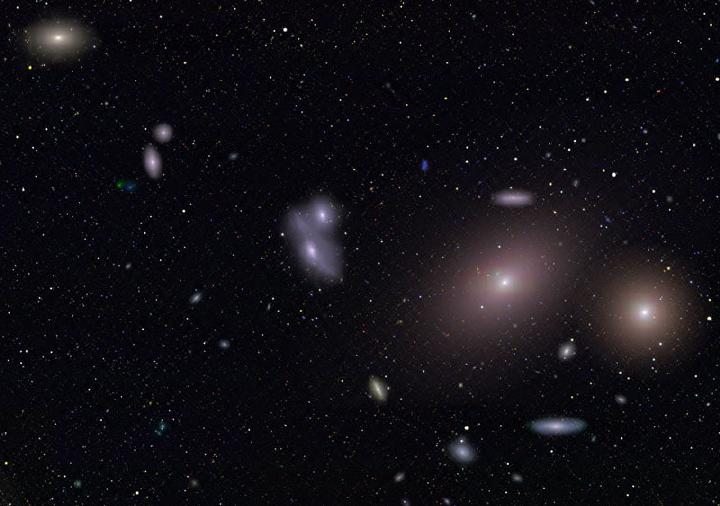
|
|
October 12, 2006 NOTE: This article is a reprint of a California Institute of Technology press release. The original can be found at http://pr.caltech.edu/media/Press_Releases/PR12898.html. New Window of Universe Opens at Griffith; Unprecedented Image from Palomar
PASADENA, Calif.--Caltech scientists have produced the largest astronomical image ever in order to inspire the public with the wonders of space exploration. The image has been reproduced as a giant mural in the new exhibit hall of the landmark Griffith Observatory, which will reopen Nov. 3 after several years of renovation. A team led by Caltech Professor of Astronomy George Djorgovski used data from the Palomar-Quest digital sky survey, an ongoing project at the Samuel Oschin Telescope at Palomar Observatory, which is owned and operated by Caltech. The survey is a joint venture between groups at Caltech and Yale University. The great cosmic panorama, named The Big Picture, is 152 feet long by 20 feet high, and it covers the entire wall of the Richard and Lois Gunther Depths of Space exhibit hall at Griffith Observatory. It is displayed on 114 steel-backed porcelain enamel plates, expected to last many decades, and it will be viewed by millions of visitors annually. "We wanted to inspire the public and convey the richness of the deep universe and its understanding, and to do it with a real scientific data set," says Djorgovski. "We are doing research with these data, but there is also a sense of beauty and awe, which is important to communicate, especially to young people." The image covers only a sliver of the visible sky, less than a thousandth of the celestial sphere, roughly an area your index finger would cover if held about a foot away from your eyes. The entire Palomar-Quest sky survey covers an area about 500 times greater. The part of the sky covered by The Big Picture is in the constellation of Virgo, and it spans the core of the Virgo cluster of galaxies, about 60 million light years away; the light from the brightest galaxies seen in the picture started its journey when dinosaurs ruled the Earth. "What is perhaps most striking about the image is the wealth of the information in it, and the remarkable diversity of cosmic objects it shows," says Ashish Mahabal, the project scientist for the survey. Aside from the prominent bright galaxies in the Virgo cluster, which dominate the view, the image contains nearly a million much fainter and more distant galaxies; hundreds of thousands of stars in our own galaxy (the Milky Way); a thousand quasars (luminous objects believed to be powered by massive black holes) with distances up to 12 billion light-years away, hundreds of asteroids in our own solar system; and at least one comet. The data used to construct the image were obtained by the Caltech-Yale team in the course of over 20 nights at the Samuel Oschin Telescope at Palomar in 2004 and 2005. The data were then transferred to Caltech, Yale, and other locations via the High Performance Wireless Research and Education Network. Several hundred gigabytes of raw data were then distilled to produce a 7.4-gigabyte color image, using cutting-edge technology at Caltech's Center for Advanced Computing Research. "This project illustrates a powerful synergy between modern astronomy and advanced computing, which is increasingly becoming a driving force for both research and education," says Roy Williams, a scientist on the team, and one of the leaders of the U.S. National Virtual Observatory effort. "We plan to use The Big Picture as a magnet and a gateway to learning, not only about the universe, but also about the computing and information technology used to create the mural." Sky surveys are a large part of the scientific history and legacy of Palomar Observatory starting with the pioneering work of Caltech professor Fritz Zwicky in the 1930s. He used the first such survey to discover numerous supernova explosions, large-scale structures in the universe, and other wonders. A major photographic sky survey conducted in the 1950s at the 48-inch telescope provided the first modern atlas of the sky, guiding many astronomical inquiries. The telescope was later named in honor of Samuel Oschin, the late Los Angeles business leader and philanthropist. Successive surveys at the same telescope, including the current Palomar-Quest project, continue to provide fundamental data sets for astronomy. They have led to numerous important discoveries, ranging from the outer reaches of the solar system to the very distant universe. In addition to The Big Picture, several exhibits at Griffith have strong connections to Caltech and Palomar, including a model of the Hale 200-inch Telescope, which was a major engineering feat at the time of its construction and has been at the center of many groundbreaking astronomical discoveries for nearly half a century. A Big Picture education/public outreach website will become active following the Griffith Observatory reopening: http://bigpicture.caltech.edu. The Caltech team that created The Big Picture includes Djorgovski; staff scientists Mahabal, Williams, Matthew Graham, and Andrew Drake; graduate students Milan Bogosavljevic and Ciro Donalek; digital image experts Leslie Maxfield, Simona Cianciulli, and Radica Bogosaljevic; and several staff members at Palomar Observatory and the Center for Advanced Computing Research. Members of the Yale team who contributed data and observations include Charles Baltay, David Rabinowitz and Nan Elman, graduate student Anne Bauer, and several others. The work was supported mainly by the National Science Foundation. Contacts:
Visit the Palomar Observatory website at http://www.astro.caltech.edu/palomar/. Visit the Center for Advanced Computing Research website at http://cacr.caltech.edu. NOTE: The following image and caption was copied from a NASA "Astronomy Picture of the Day" web site. The original can be found at http://antwrp.gsfc.nasa.gov/apod/ap061011.html.
|
